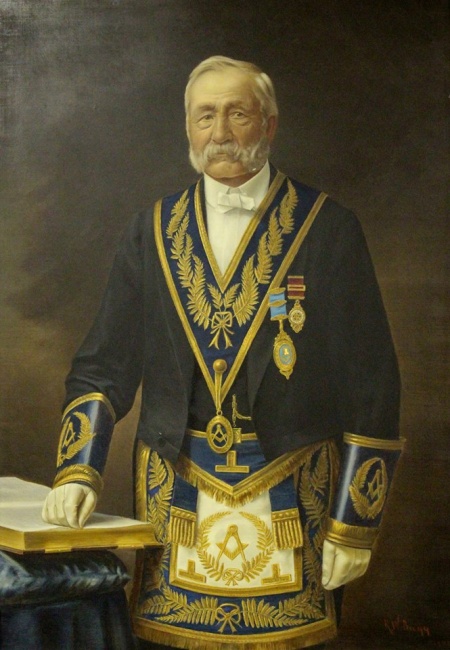En: William Charles Vahland: Unterschied zwischen den Versionen
(Die Seite wurde neu angelegt: „thumb|350px“) |
Keine Bearbeitungszusammenfassung |
||
| Zeile 1: | Zeile 1: | ||
[[Datei:Vahland.jpeg|thumb| | [[Datei:Vahland.jpeg|thumb|450px]] | ||
== William Charles Vahland == | |||
The National Trust Heritage Festival from April 18 to May 26, 2015 will commemorate a milestone centenary – the death of William Charles Vahland, one of Australia’s most important 19th Century architects | |||
Vahland designed over 200 buildings across Greater Bendigo and the Goldfields region over nearly six decades. He left his mark most prominently in Bendigo by designing The Capital Theatre, the Bendigo Art Gallery, the Bendigo Town Hall and the Alexandra Fountain, which are all magnificent testaments to the vision of this man. | |||
A German migrant, Vahland arrived in Melbourne by ship in 1854 and travelled straight to the Bendigo goldfield in search of riches. It was three years after gold was first discovered in the Bendigo Creek but he did not strike it lucky. | |||
Instead Vahland, like many migrants, saw there were many other opportunities in his new country. There were miners aplenty but what the goldfields needed were builders and architects to develop permanent buildings and layout a town centre. Drawing on his architectural training, Vahland built his own home in Barkly Terrace (which still stands today) and opened the first of four architectural practices at 2 Pall Mall Chambers with German architect Robert Getzschmann. | |||
But Vahland not only designed the gems of Bendigo’s civic buildings, the centre of Echuca, where he also had an office, is the result of Vahland’s genius for designing buildings that are grand and elegant but also serve a judicial and civic purpose. He was not a man to restrict his craft and skill to a specific form and designed hotels, churches, banks, theatres, libraries, colleges and schools, wine cellars, hospital buildings, fountains, residences and ornamental features such as gates. | |||
Vahland, who later became an Australian citizen, also nurtured the idea of the ‘great Australian dream’. He built a number of homes called ‘Vahland Villas’ and assisted with developing a building society to loan money to help the miners move out of tents and work towards owning their own home. Today, that loan scheme is better known as the Bendigo Bank. | |||
During May 2015 come and see for yourself the incredible legacy left by one man who shaped the Goldfields region. Click here to see all the events related to Vahland celebrations. | |||
Version vom 16. Juni 2015, 20:44 Uhr
William Charles Vahland
The National Trust Heritage Festival from April 18 to May 26, 2015 will commemorate a milestone centenary – the death of William Charles Vahland, one of Australia’s most important 19th Century architects
Vahland designed over 200 buildings across Greater Bendigo and the Goldfields region over nearly six decades. He left his mark most prominently in Bendigo by designing The Capital Theatre, the Bendigo Art Gallery, the Bendigo Town Hall and the Alexandra Fountain, which are all magnificent testaments to the vision of this man.
A German migrant, Vahland arrived in Melbourne by ship in 1854 and travelled straight to the Bendigo goldfield in search of riches. It was three years after gold was first discovered in the Bendigo Creek but he did not strike it lucky.
Instead Vahland, like many migrants, saw there were many other opportunities in his new country. There were miners aplenty but what the goldfields needed were builders and architects to develop permanent buildings and layout a town centre. Drawing on his architectural training, Vahland built his own home in Barkly Terrace (which still stands today) and opened the first of four architectural practices at 2 Pall Mall Chambers with German architect Robert Getzschmann.
But Vahland not only designed the gems of Bendigo’s civic buildings, the centre of Echuca, where he also had an office, is the result of Vahland’s genius for designing buildings that are grand and elegant but also serve a judicial and civic purpose. He was not a man to restrict his craft and skill to a specific form and designed hotels, churches, banks, theatres, libraries, colleges and schools, wine cellars, hospital buildings, fountains, residences and ornamental features such as gates.
Vahland, who later became an Australian citizen, also nurtured the idea of the ‘great Australian dream’. He built a number of homes called ‘Vahland Villas’ and assisted with developing a building society to loan money to help the miners move out of tents and work towards owning their own home. Today, that loan scheme is better known as the Bendigo Bank.
During May 2015 come and see for yourself the incredible legacy left by one man who shaped the Goldfields region. Click here to see all the events related to Vahland celebrations.

